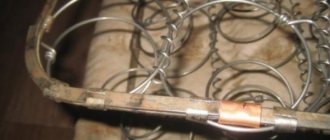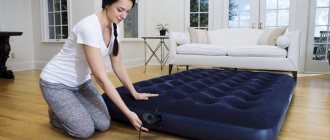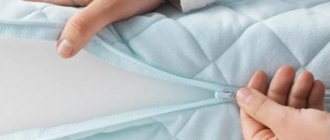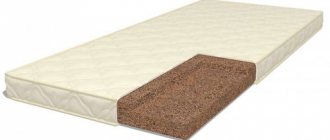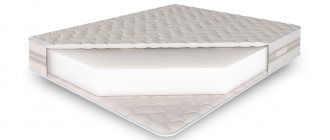- home
- Author's articles
- Useful articles
A mattress is a soft bed base that can be with or without a frame. It comes in several types, but in everyday life, only two are most often used - spring and stuffed. In our article we will talk specifically about spring types, which, in turn, are divided into two types.
- With a continuous weave of springs called Bonnell
- With independent blocks of springs, which are considered orthopedic
The first type is more common. It is inexpensive, so it is very popular. The second type has greater capabilities, but is also more expensive. In any case, the subject of discussion consists of a spring block or shock-absorbing parts, a hard layer, a cover and a filler. The latter can be both soft and hard. As for the covering, it is better that it be made of natural fabric.
What is needed for repair?
The list of tools and materials needed to repair a mattress, of course, directly depends on the type of damage. And you can figure out what’s wrong, why the springs came out, only by removing the upholstery.
Therefore, you definitely need to stock up on material for new upholstery and do not forget that you will need not only beautiful and durable fabric, but also layers of sealing, as well as material for the inner cover.
You will also need:
- hammer and pliers;
- thin nails, usually 50-60 mm and furniture nails;
- clamps;
- stationery knife and scissors;
- needles and strong threads, preferably regular twine or synthetic;
- cushioning material - synthetic rollers or rubber;
- strong thick wire, about 5 mm thick;
- manual or electric stapler;
- spare springs.
Optionally, you may also need other materials and tools; their list depends on the type of breakdown and the type of mattress itself. For example, modern orthopedic spring mattresses are designed completely differently from old “grandmother’s beds.” You can’t do without a vacuum cleaner, since dust constantly accumulates inside the mattress.
Stages of the recovery process
Lack of skills in restoring spring mattresses is not a reason to refuse to do it yourself, especially... if you want to get down to business! By deciding to restore the product yourself, you can significantly save money, which would be better spent on purchasing materials for repairing a sofa or mattress. And you will definitely need them. You may need:
- Construction staples, nails, stapler, hammer
- Strong twine for tying (not jute, but synthetic!)
- Sheet of filler material to replace the interlayer (PPU, coir, struttofiber)
- Cushioning material placed between the spring block and the filler layer (non-woven fabric, spunbond, linen, hard felt)
- New upholstery fabric for exterior cover (as needed)
- Wood slats
- Springs
From the list-list, new springs are usually the hardest to find. The reason lies in the block production technology. The name of the design explains it: a block with continuous weaving. The production and assembly of blocks is carried out in factories and not manually, but on automatic and semi-automatic devices. Therefore, it is problematic to find separate springs for such a block on sale.
If you don’t have contacts at the Bonnell block factory, you can use intact elements from another mattress to replace one or more springs.
Stage 1. Disassemble the mattress - assess the situation
Please note that over the years of use, a large amount of dust has accumulated in the mattress. Therefore, it is better to disassemble the product outside the home. Dismantling work can be carried out in the garage, at the dacha or directly on the street.
- Before you begin, thoroughly vacuum the upholstery and assess its condition - whether it can be reused or not.
- Place the mattress on a table or four stools with the base upside down.
- Next, depending on the decision made regarding the future “fate” of the outer skin, choose a method for removing it. If the fabric cannot be reused, you can simply tear it off with sharp movements, then fold it and throw it in the trash. If you decide to keep the upholstery, wash it and reuse it, you will have to approach the removal more carefully (without tearing it off, but removing each fastening bracket or nail individually). Important! Be careful when dismantling old fittings. In order to later install it in its original place without any problems, you can make notes along the way with a marker.
- Next, we evaluate the condition of the flooring (the soft layer between the spring block and the outer skin). Most likely, it will be discovered that the service life of the layers of flooring (felt, foam rubber) has long been exhausted and requires immediate replacement.
- After removing the flooring, carefully vacuum the spring block inside.
- We inspect the side frame (if there is one).
- We inspect the base (bottom).
Advice! If in the design of your mattress the role of the base is performed by belts, bodice or elastic rubber bands, it is better to replace them with wooden slats. To do this, prepare wooden slats of the required size. The slats should be secured in the same places where the tapes were attached.
Stage 2. Assess the complexity of damage in the spring block
After dismantling the main parts, you can proceed to assessing the condition of the spring block. Carefully inspect it for dents, weakened or burst springs. Since the unit with the dependent system was not made manually at the factory, the word “repair” will rather mean a number of life hacks and tricks. The real repair of the Bonnell block (in the case of burst or severely deformed springs) consists of its complete replacement. If this is not possible, you will have to tinker with replacing individual elements.
Reference! If the spring block is seriously damaged, you can save time and simplify the task by replacing the spring block with a springless filler. Getting PU foam for a mattress today is not a problem. The main thing is to take time and understand the brands in order to buy material of sufficient density and rigidity.
Stage 3. We tie the springs
If the spring block is not damaged, the wooden frame and base are intact (or can be repaired), and the problem is mainly sagging, the solution will be the proven “old-fashioned” method - tying the springs. This technique will allow you to “pull” weakened springs to a common level, level the plane, give elasticity to the mattress and extend the life of the product.
Reference! The springs are tied using durable synthetic twine.
- We hammer construction staples into the top slats of the side frame (if the frame is wooden) (not completely) opposite the rows with springs. It is to these “loops” that the binding cord will be attached (at the beginning and at the end of each row of springs) to secure the harness to the frame.
- Next, we proceed to tying the transverse (short) rows.
- Then we move on to long longitudinal rows.
- Finally, we perform a diagonal strapping. Important! As you proceed with the strapping work, make sure that the height of the springs is the same (in sagging areas, pull the twine tighter). At the same time, the cord tension should not be too tight. The harness should not pull the springs too tightly together. It is important to catch and feel the tension.
- At the end, we hammer in all the staples on the wooden frame (through which the twine is threaded) until they stop.
Stage 4. Restoring the springs
If, after opening the casing, it turns out that the springs are broken, you cannot do without replacing the elements. If one or two springs are broken, it is enough to replace only them. Unfortunately, as a rule, in blocks of old mattresses you can find entire rows of broken springs in the central part of the mattress (the part that was subjected to the greatest stress). There are two options to solve the problem.
- Complete replacement of the spring block. This method is more reliable and simple, but requires the presence (or purchase) of a similar working unit.
- Partial block replacement. In this case, you will have to dismantle the wooden frame to provide access to the spring rows on both sides. After this, the damaged area is removed and a new one is installed in its place.
Advice! When performing a partial block replacement, cut the edges of the metal spring binding wire that holds the rows of main springs together and unscrew it counterclockwise. After removing the old one and installing the new element into the block, screw it back in.
Stage 5. Restoring the casing
To upholster (cover) a sofa or frame mattress accurately, you will need a furniture stapler.
- First we lay the substrate, the so-called “drum”. Reference! This is a fabric (you can use the old one), which is stretched directly onto a spring block and secured with a stapler to a wooden frame.
- On top we lay a softening layer (or several) - polyurethane foam, coir.
- To prevent the wooden frame from breaking through the new fabric, we put padding polyester (thin foam rubber) on the corners of the slats. This will also add comfort while sitting on the mattress.
- Lastly, we cover the repaired product with furniture fabric.
- If the bottom of the mattress was sewn with a backing, install it in its original place.
What will you have to face?
Of course, there are quite a lot of options for mattress breakdowns and their combinations. But, as a rule, people who start repairs have to face one of the following problems:
- the need to replace upholstery materials;
- damage to the sealing material;
- springs disconnected from the base;
- deformation of spring blocks;
- cracks in the mattress arm.
Usually, the problem is rarely the only one; as a rule, a combination of them is observed. This is especially true for old things that have been repaired many times.
In what cases is repair work required?
Self-repair of the inner spring may be required in the following common situations:
- damage to rail fastenings;
- deformation or breakage of springs;
- rupture of the outer shell of the device;
- mechanical resizing of built-in components;
- breakdown of the external or internal frame;
- failure of the corner bracket.
In each individual case, the owner of the product must correctly carry out diagnostics, as well as high-quality repairs, so that in the future he will no longer encounter deviations in the operation of the accessory.
Important. Before repairs, it is recommended to conduct a thorough visual inspection, which will eliminate the possibility of missing parts that require urgent replacement.
How to connect spring blocks?
After the repair, the task of pairing the spring blocks becomes urgent.
At home, this problem can be solved as follows:
- third-party blocks are attached to the frame;
- a nail is driven in in front of each row of springs, at the level of the frame, you need to repeat how the springs were originally installed;
- the two outer springs of the horizontal row are fastened together;
- the spring is fixed vertically;
- all manipulations are repeated.
As soon as the longitudinal rows are secured, you need to tie the springs with twine or twine, thread, or thin copper wire together. This will ensure reliable fastening of the entire structure. After mating, all “extra” nails are removed, leaving only those parts that are necessary in the structure.
When does a mattress need repair?
It is not difficult to understand that a mattress needs repair. Often, this is visible to the naked eye, not to mention the sensations (when you sit or lie on it). The most common injuries include:
- Wear of the outer skin (holes, abrasions)
- Wear of the soft layers of filler separating the spring block from the outer casing (the springs are printed or felt)
- Damage to the wooden frame and/or base
- Curvature, weakening or breakage of the springs themselves in the block
This is not a complete list of damages. It can be expanded depending on the existing model.
Recovery instructions
In order to properly repair the accessory, it is necessary to carry out repair work in accordance with the following step-by-step algorithm:
- All elements must first be cleaned;
- Next, a thorough inspection of the device is performed;
- components are checked for functionality;
- the rack fastening is removed;
- the spring is being knitted or replaced;
- the device is assembled in reverse order;
- The product is re-plated.
Stage 1: Removing the upholstery and cleaning
Experts recommend repairing a mattress outside or in a garage, but if this is not possible, it is permissible to do it at home. The entire structure should be placed on a flat horizontal surface or several stools so that the structure can be approached from any side.
In most cases, the top decorative cover is closed with a zipper along the entire perimeter; it is easy to remove and remove the structure itself. If the outer material is stitched, it should be ripped apart; it is not necessary to cut all the seams; it is enough to separate the parts of the cover on one side. Then carefully remove the sealing and cushioning fabric that covers the springs.
In modern mattresses, the lining fabric is glued with strong glue. To remove it, carefully cut the glued seams with a sharp knife.
If the mattress has been in use for a long time, a large accumulation of dust may form in it, which should be removed with a household or car vacuum cleaner. At this stage, you should thoroughly clean all parts of the mattress. If the sealing and lining material has become unusable, it is recommended to replace it with a new one or wash it.
Sheathing of the product
The final stage of repair is reupholstering the mattress with outer upholstery. To do this, first cover the spring block with a lining. The material must be dense, for example, tarpaulin (burlap or dermantin is also suitable). So, the lining base is placed on top of the spring block and secured with it with a regular stapler.
Then take a sealant (foam rubber, padding polyester). These rollers are placed on the lining in selected places. This ensures high-quality styling. The top of the mattress product should be covered with decorative fabric, and the edges of the upholstery should be carefully tucked inward.
The principles according to which our masters work:
- Professionalism. Our craftsmen are constantly engaged in self-improvement, which is why they provide the best repair of air mattresses in Moscow.
- Experience. In order to properly repair a mattress, you must have extensive experience working with such things. All our masters have been repairing various mattresses for several years now. That is why our technicians can fix any problem.
- Speed. We quickly carry out all repair work.
- Reliability. Many people are afraid to send their items to workshops because they are afraid that their products will be damaged. You can easily call a specialist to your home, they will repair the mattress at home. You can be confident in the reliability of our craftsmen.
Repairing mattresses in our workshop will not take much time, everything will be done quickly and efficiently, because we have the best professional craftsmen who can carry out any repair work, even the most complex. So if you notice any problem with your mattress, immediately bring it in for repair. In our workshop it will be executed in the best possible way. You shouldn’t put off repairing your mattress, because the sooner you solve this problem, the cheaper it will cost you. After all, if you solve the problem initially, when it first appears, you can avoid further breakdowns, the repair of which will take longer and be more expensive. So learn to fix breakdowns right away.
Fastening
The stage that requires the most effort and time. It includes several steps:
- checking the serviceability of parts;
- frame installation;
- spring binding.
First, remove the cord connecting the springs and remove the nails from the frame. Then you need to inspect the springs and return them to their original position. Broken parts are thrown away and new ones are installed. To do this, the springs are nailed to the slats using nails that are bent inward. It is first recommended to make precise markings on the body of the product.
It should be taken into account that in orthopedic mattresses the individual springs are located in special bags
. And in conventional ones there are three methods of fastening:
- using wooden slats. Sometimes it is enough to simply hammer a loose part;
- the use of fabric straps over wooden slats;
- fabric belts. They give the mattress orthopedic properties.
If fabric straps were used in the manufacture of the mattress, you will need to cut out the wooden slats yourself. Elastic fabric straps are attached to them. The length of the slats should correspond to the width of the mattress.
To replace the spring bag in orthopedic models, you will need an element with new springs. It is sewn in using a regular needle and strong thread.
Harness
After checking and securing the springs, the strapping process is carried out. For this purpose you will need a strong rope (diameter about 3 cm). First, take nails and drive them opposite a separate spring row. Then the nails are bent to create peculiar hooks. The cord will be wound around them.
First of all, you need to deal with tying the transverse springs. Each spring is processed separately with a cord. Then they begin to tie the elements in the longitudinal direction. For efficiency reasons, they are fastened with transverse ones.
Finally, the springs are processed diagonally. The angle with respect to the previous harnesses should be 45 degrees. At the end of this work, the nails left by the hooks are completely bent.
